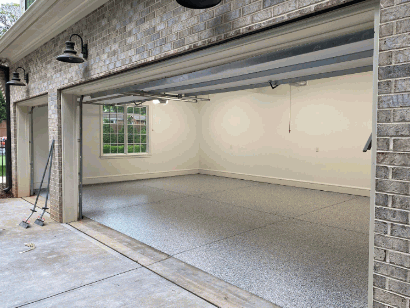Table of Contents
Have you ever considered upgrading your garage floor with epoxy coating?
Epoxy flooring is a popular choice for many homeowners due to its durability, easy maintenance, and aesthetic appeal.
In this article, we will explore what epoxy flooring is, why it's a great option for your garage, and the step-by-step process of applying it.
We will also discuss the benefits of epoxy flooring, the costs involved, and how long you can expect it to last.
If you're looking to transform your garage, keep reading to learn more about epoxy flooring!
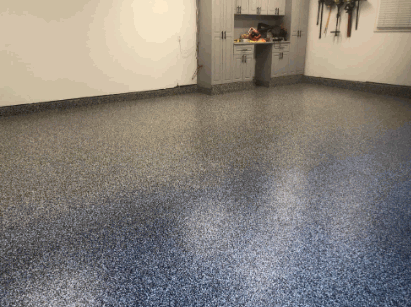
Epoxy flooring is a durable and versatile solution commonly used to coat garage floors, providing a protective layer that enhances the floor's appearance and longevity. It involves applying a two-part resin and hardener coating, creating a strong bond with the concrete surface.
Regarding the application of epoxy flooring, there are two main methods: the DIY approach and professional installation. The DIY route involves carefully following the manufacturer's instructions, which typically include steps like surface preparation, mixing the resin and hardener, and evenly spreading the mixture over the floor. On the other hand, opting for professional installation guarantees a flawless finish, with experts using specialized tools and techniques to ensure a seamless application.
One of the key benefits of epoxy coatings for garage floors is their exceptional durability. The hardened surface is resistant to stains, chemicals, impacts, and abrasions, making it ideal for high-traffic areas like garages. Epoxy floors are easy to clean and maintain, requiring simple sweeping and occasional mopping to keep them looking fresh.
Explore: What Is Epoxy Flooring
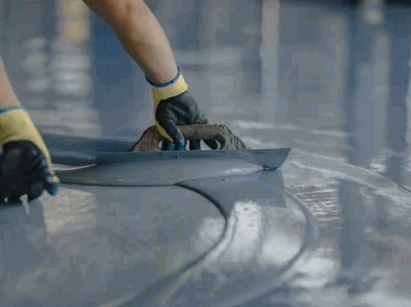
Selecting epoxy flooring for your garage comes with various advantages, including its durability, easy maintenance, and cost-effectiveness over time. It provides a seamless and attractive finish, enhancing the overall look of the garage while offering long-term protection.
Epoxy flooring is highly resistant to stains, chemicals, and scratches, making it ideal for withstanding the heavy use and potential spills that often occur in garages. Its smooth surface is easy to clean, requiring only simple sweeping and occasional mopping to maintain its pristine appearance. The cost-effectiveness of epoxy flooring lies in its long lifespan and low maintenance requirements, which ultimately save money in the long run compared to other flooring options.
The aesthetic appeal of epoxy flooring is another compelling reason why many homeowners opt for this type of flooring in their garages. With its customizable colors and glossy finish, epoxy can transform a dull and ordinary garage into a vibrant and stylish space. Whether you prefer a solid color or decorative flakes for a more textured look, epoxy offers versatility in design to suit various preferences.
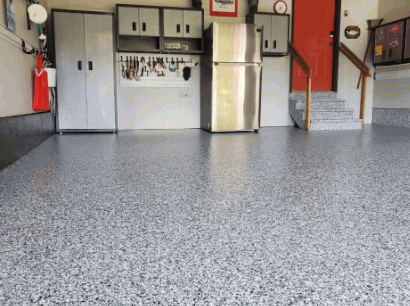
The process of applying epoxy flooring in a garage involves several essential steps to ensure a successful outcome. From preparing the garage floor to applying the epoxy coating, each stage plays a crucial role in achieving a professional and durable finish.
To start the project, it is imperative to thoroughly clean the concrete surface, ensuring all dirt, grease, and debris are removed. This step not only promotes better adhesion of the epoxy but also enhances the overall appearance of the flooring. Cleaning the garage floor typically involves scrubbing with a degreaser, followed by rinsing and allowing ample time to dry completely. Once the surface is clean, any cracks or imperfections should be filled and repaired to create a smooth base for the epoxy application.
Before applying epoxy coating, preparing the garage floor is crucial to ensure proper adhesion and longevity. This step involves cleaning the surface thoroughly, repairing any damage, and using an etching solution to create a rough surface for better epoxy adhesion.
To properly prepare the garage floor, start by removing all items from the space, including vehicles and equipment. Sweep the floor to remove any loose debris, then proceed to scrub the surface with a degreaser to eliminate oil stains and dirt buildup. Next, gather the necessary tools such as a pressure washer, scrub brush, and mop to deep clean the floor. Once cleaned, inspect the floor for cracks or chipped areas that require repair before moving on to the next step.
Repairing cracks and holes in the garage floor is essential to create a smooth and even surface for the epoxy coating. Use a suitable epoxy filler to patch any imperfections and ensure a seamless finish.
Before starting the repair process, it's crucial to thoroughly clean the area to remove any debris, dust, or existing coatings that may hinder the adhesion of the filler.
Once the surface is clean and dry, carefully apply the epoxy filler into the cracks and holes using a putty knife, ensuring that it is level with the surrounding floor.
Allow sufficient time for the filler to cure and harden before sanding it down to achieve a flush finish.
This meticulous preparation not only enhances the aesthetics of the garage floor but also improves the durability of the epoxy coating.
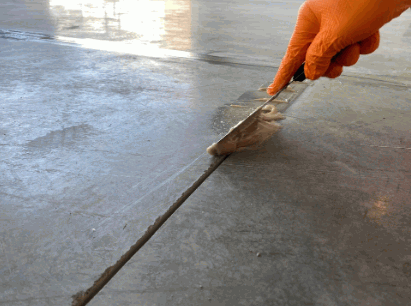
Thoroughly cleaning the garage floor is a crucial step before applying epoxy coating. Removing any grease, oil, or debris ensures proper adhesion and a smooth finish for the epoxy to bond effectively to the surface.
To start preparing the garage floor, begin by clearing out any items and sweeping the surface to remove loose dirt and dust. Use a broom or vacuum to ensure all corners and edges are free of debris. Next, choose a suitable cleaning agent such as a degreaser or concrete cleaner. Dilute the cleaner as instructed and apply it generously to the floor. Use a scrub brush or mop to work the cleaner into the surface, focusing on areas with stains or built-up grime.
Rinse the floor thoroughly with water to remove all cleaning residue. It's essential to allow the surface to dry completely before moving on to the next step. Check for any lingering spots that may require additional cleaning. Once the floor is clean and dry, you're ready to apply the epoxy coating for a durable and attractive finish.
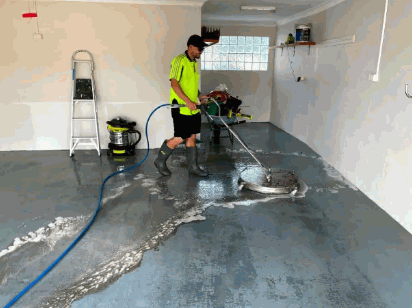
Applying a primer on the garage floor is essential to create a strong bond between the surface and the epoxy coating. The primer enhances adhesion and helps the epoxy layer adhere firmly to the concrete.
Without this crucial step, the epoxy coating may not properly adhere, leading to potential issues like peeling or chipping over time. By providing a stable base for the coating, the primer ensures the longevity and durability of the project. The primer can also help prevent moisture transmission through the concrete, effectively reducing the risk of bubbling or blistering that might occur without proper preparation. Investing time in applying primer before the epoxy coating can significantly improve the overall finish and performance of your garage floor.
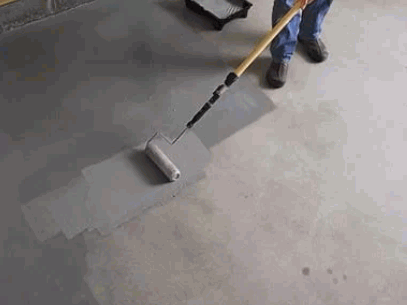
Mixing the epoxy coating correctly is crucial for achieving the desired results in your garage flooring project. Follow the manufacturer's instructions carefully to ensure a proper blend of resin and hardener for a durable finish.
Manufacturers typically provide specific ratios of resin to hardener for their epoxy coatings, which must be followed diligently to avoid issues like poor adhesion or incomplete curing.
Furthermore, mixing the components thoroughly is essential to activate the chemical reaction that gives epoxy its strength and durability. It's recommended to use a drill with a mixing attachment to ensure a homogenous mixture.
Take note of any specific temperature or humidity requirements outlined by the manufacturer, as these factors can significantly impact the curing process and overall performance of the coating.
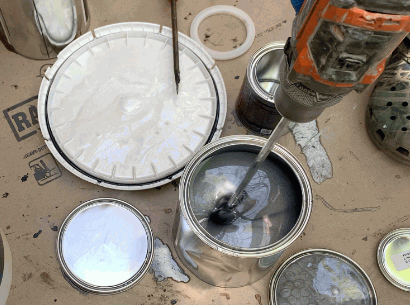
Applying the epoxy coating evenly and smoothly is a critical step in achieving a professional finish for your garage floor. Follow the application instructions carefully, ensuring complete coverage and a uniform appearance.
Start by thoroughly cleaning the garage floor surface to remove any dirt, grease, or oil that may affect the adhesion of the epoxy. Allow the floor to dry completely before proceeding with the application. Proper preparation is key to a successful outcome.
Next, mix the epoxy resin and hardener according to the manufacturer's instructions. Use a quality tool such as a roller or brush to apply the mixture in even strokes, working in small sections to maintain control over the coverage. Make sure to follow the recommended thickness for the best results.
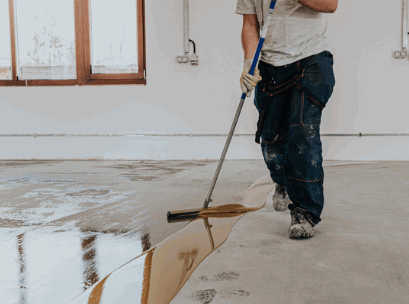
For an added aesthetic touch, you can choose to incorporate decorative chips into the epoxy coating on your garage floor. These color chips not only enhance the appearance but also provide texture and slip resistance.
When considering a garage flooring project, adding these color chips can significantly transform the overall look of the space. The variety of colors available allows you to personalize your floor and match it with the rest of your garage decor.
Beyond the visual appeal, the incorporation of decorative chips also adds functionality. The chips create a slightly rough surface, making the floor less slippery, especially when wet, providing an added safety feature.
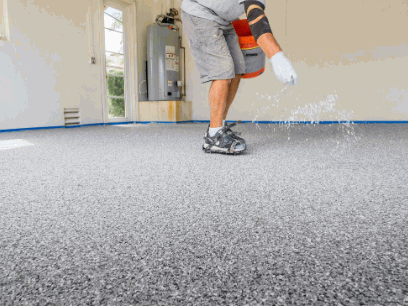
Applying a topcoat over the epoxy finish adds an extra layer of protection and enhances the durability of the garage floor. This step not only improves longevity but also simplifies maintenance and cleaning.
By sealing the epoxy flooring with a topcoat, you create a barrier that shields the surface from stains, chemicals and wear and tear.
The added protective layer not only increases the lifespan of the floor but also makes it easier to wipe off spills and dirt, keeping the surface looking fresh and new.
The topcoat adds an extra level of resistance to abrasions and impacts, making the flooring more resilient to heavy use and traffic.
Epoxy flooring offers numerous advantages for garage spaces, including enhanced durability, easy maintenance, and chemical resistance. It improves lighting by reflecting light, enhancing safety within the garage environment.
Due to its seamless and non-porous nature, epoxy flooring creates a smooth surface that is resistant to stains, cracks, and impacts, making it ideal for high-traffic areas like garages. This not only enhances the longevity of the floor but also reduces the need for frequent repairs and replacements, saving both time and money in the long run.
The enhanced lighting provided by the reflective properties of epoxy flooring not only brightens up the space but also contributes to a safer working environment, minimizing the risk of accidents caused by poor visibility. This, combined with the anti-slip characteristics of epoxy coatings, offers an additional layer of safety, particularly in environments where spills or moisture can be common.
One of the key benefits of epoxy flooring in the garage is its exceptional durability, providing a long-lasting and resilient coating that protects the surface from wear, impact, and chemical exposure.
Epoxy flooring is a popular choice for garage surfaces due to its ability to withstand heavy usage and harsh conditions. The protective properties of epoxy create a tough barrier that shields the underlying surface from scratches, stains, and spills, ensuring a clean and well-maintained look for years to come.
The durability of epoxy coatings extends to resistance against UV rays, which helps prevent color fading and maintains the vibrancy of the floor finish. This resilience makes epoxy flooring a cost-effective solution, requiring minimal maintenance and offering long-term savings.
Maintaining epoxy flooring in the garage is hassle-free due to its seamless and non-porous surface, which resists stains and is easy to clean. Regular sweeping and occasional mopping are usually sufficient to keep the floor looking pristine.
The seamless and non-porous surface of epoxy flooring not only provides resistance to stains but also simplifies the cleaning process, making it an ideal choice for high-traffic areas like garages. Due to its impermeable nature, liquids and dirt cannot penetrate the surface, allowing for easy maintenance with just basic cleaning routines. This durability also means that epoxy flooring can withstand heavy foot traffic and vehicle movement without showing signs of wear and tear, ensuring a long-lasting and aesthetically pleasing flooring solution.
Epoxy flooring for garages offers excellent resistance to chemicals and stains, making it ideal for environments prone to spills and contaminants. The protective layer prevents damage from oils, solvents, and other substances.
Additionally, epoxy flooring creates a seamless surface that inhibits the penetration of corrosive materials, ensuring long-lasting durability in high-traffic areas. This durable flooring solution not only protects the underlying concrete from wear and tear but also adds a layer of safety by offering slip-resistant properties, enhancing overall functionality.
Epoxy flooring can enhance lighting conditions in the garage by reflecting light off its smooth surface, creating a brighter and more illuminated space. This feature contributes to a safer and more visually appealing environment.
When natural or artificial light sources come in contact with the epoxy-coated floor, the reflection phenomenon occurs. This reflection factor ensures that light is not absorbed but is instead bounced off the surface, spreading across the room. This results in a more evenly brightened area, minimizing shadows and dark spots. With enhanced lighting, tasks such as woodworking, car repairs, or even simple storage become more manageable and efficient within the garage setting.
Safety is a priority in garage spaces, and epoxy flooring enhances it by providing slip-resistant surfaces that reduce the risk of accidents. The durable coating also offers protection against impact, creating a secure environment.
The slip resistance of epoxy flooring significantly decreases the likelihood of slips and falls, especially in areas prone to moisture or grease buildup. This feature is particularly beneficial in garages where oil spills or water leakage can occur.
The impact protection provided by epoxy flooring helps cushion the impact of heavy tools or equipment, safeguarding both the floor itself and any items that may accidentally fall. The combination of these qualities makes epoxy flooring a top choice for those seeking to prioritize safety in their garage spaces.
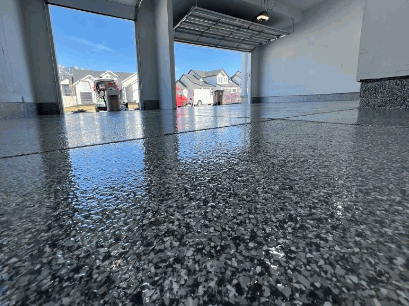
The costs of epoxy flooring for garages vary depending on factors such as materials, labor, and project size. While epoxy coating kits offer a cost-effective DIY option, professional installation may incur additional charges.
When considering the costs of epoxy flooring, materials comprise a significant portion of the expenses. High-quality epoxy coatings can range from $1.50 to $5 per square foot, depending on the brand and features. Additionally, labor costs play a crucial role. Professional installation can add $3 to $12 per square foot, while DIY projects significantly reduce labor expenses.
For a typical 2-car garage, the total cost, including both materials and labor, can range from $500 to $5000. It's essential to compare pricing from different suppliers and contractors to ensure a cost-effective solution.
The materials required for an epoxy flooring project in the garage include epoxy coating kits, cleaning solutions, and protective gear.
Choosing high-quality materials is crucial as they play a significant role in determining the overall success and longevity of the project. Using inferior materials may result in a finish that lacks durability and aesthetics, leading to the need for frequent repairs or replacements. Materials with good adhesion properties and resistance to chemicals and abrasions are essential for creating a professional-grade epoxy floor. Investing in top-notch coating products not only enhances the visual appeal of the floor but also provides a protective barrier against daily wear and tear, ensuring a polished look for years to come.
Labor costs for epoxy flooring installation in garages can vary depending on the project's size and complexity. While DIY application saves on labor expenses, hiring professionals ensures a precise and efficient finish.
When considering the labor aspect of epoxy flooring projects, it's crucial to assess your skill level and available time. DIY enthusiasts may find satisfaction in tackling the installation themselves, enjoying the hands-on approach and cost-saving benefits. However, professional installers bring expertise, experience, and access to specialized tools, resulting in a high-quality outcome that stands the test of time. These skilled professionals can navigate challenges swiftly, ensuring a seamless installation process with minimal disruptions.
Plus material and labor expenses, epoxy flooring projects may incur additional costs such as equipment rental or specialized tools. These extra investments contribute to the overall cost of the project.
When considering additional costs, it's essential to account for the equipment needed for proper installation. This includes items like concrete grinders, mixers, buckets, and brushes which might need to be rented or purchased. Specialized tools such as spiked shoes, trowels, and squeegees are crucial for achieving a professional finish. These tools not only add to the expenses, but they are also vital in ensuring a successful epoxy flooring application. Depending on the size and complexity of the project, the cost of acquiring or renting this equipment can vary significantly.
The longevity of epoxy flooring in a garage depends on various factors, including maintenance practices, the quality of the installation, and the surface's usage. With proper care and maintenance, epoxy floors can last for many years.
One of the key factors influencing the lifespan of epoxy flooring in garages is the type of maintenance it receives. Regular cleaning, avoiding harsh chemicals, and addressing spills promptly can help preserve the integrity of the epoxy surface.
The initial installation quality plays a crucial role in how well the epoxy floor withstands wear and tear over time. Proper surface preparation, correct application techniques, and using high-quality materials are essential for a durable and long-lasting epoxy flooring project.
